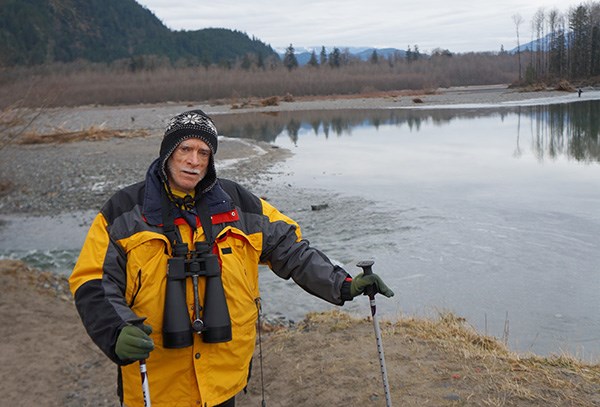The cluster of cut tree stumps along the shore stand out in stark contrast to the seemingly unspoiled Mamquam River that runs by them.
On Saturday, as Bruce Matthews stood beside the river and looked up at a large eagle sitting atop one of the remaining trees next to the CN Railway bridge on the south side of the Mamquam River dike, he said he felt “shocked” and “devastated” by the loss of the trees that were cut.
Matthews, an eagle enthusiast who volunteered with the eagle-education group Eagle Watch for 10 years, said the district came out just before Christmas and cut about 100 trees along the river including 16 that were prime eagle roosting trees.
Matthews said in previous years he has seen as many as 20 or 30 eagles at one time in those trees.
“It is the second best spot in Squamish for photographers to take pictures of eagles,” he said. Eagle Run is the best place, he said.
“The photographers could stand underneath the trees and take pictures underneath the eagles.… Because the trees were so close together and because the bridge was there, the eagles didn’t seem to mind the noise as much so you were able to approach them without them flying away.”
According to the district, the trees were cut as part of vegetation maintenance required for flood protection of dike infrastructure.
“Approximately 1.3 km of vegetation was cleared from the rip rap on the south side of the Mamquam River. This is the beginning of a multiyear project to address vegetation on the 23 km of dike infrastructure within Squamish,” read a statement to The Squamish Chief from the district.
“Over 90 per cent of the removal was alder that was less than 15 years old. These trees were small enough that they were chipped in place. Most of the vegetation in the natural overbank (water’s edge) was left in place.”
Matthews said he is not convinced the trees needed to be cut for flood protection.
“That rationale doesn’t work for that particular place because they kept three or four trees by the water and cut the trees right behind them,” he said
Matthews said the most upsetting thing of all about the loss of the trees is that the eagles may not keep coming back to the area now that some of their usual roosting trees are gone.
“Eagles are creatures of habit and they come back year after year, and they tend to go back to the same trees they sit in during the day. People don’t realize when they cut those trees down, when the eagles come back they become very confused and they will often leave an area that they had frequented,” he said.
“I think the city is out of control,” he said.
A current spokesperson for Eagle Watch declined to comment for this story because she said the club was unaware of any trees being cut.




